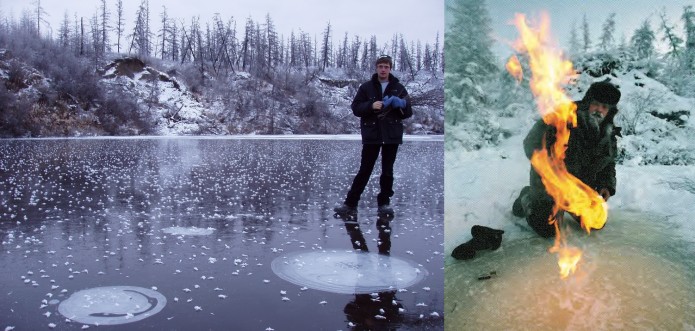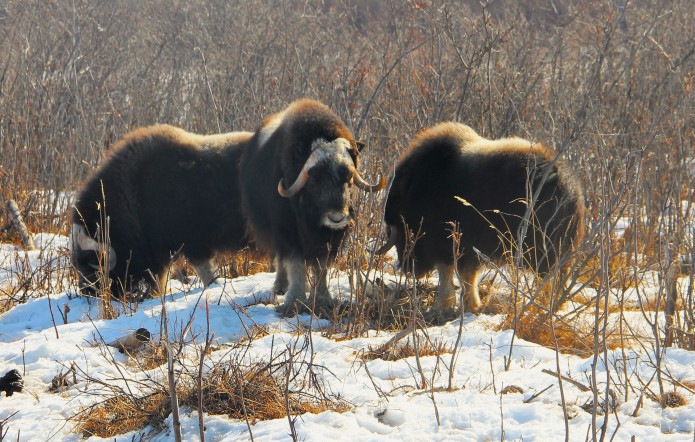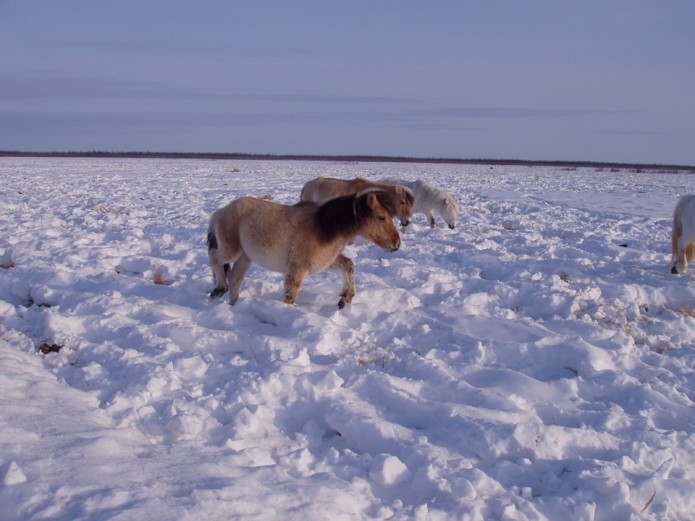
If the recently released Jurassic World: Fallen Kingdom has you yearning to see the ancient creatures in real life, you are out of luck. That’s because to resurrect the animals, researchers would need a complete set of dinosaur DNA, which is impossible to obtain. However, if Nikita and Sergey Zimov have their way, a prehistoric Ice Age ecosystem may soon become a reality. Their motive is not to attract tourists but to stop the thawing of the Arctic permafrost.
The thick layer of frozen subterranean soil that covers the Arctic and sub-Arctic regions holds billions of tons of carbon, which is released into the atmosphere as toxic carbon dioxide or methane when it melts. Hence, if the permafrost loss is not halted, the large amounts of expelled greenhouse gases will exacerbate our global warming woes. Additionally, the melting of the frozen layer leads to erosion in the barren Arctic landscape and results in massive gaping holes, like the ever-expanding 1-kilometer-long (0.62 miles), almost 100-meter-deep (328 feet) Batagaika crater in Eastern Siberia.

Sergey and Nikita believe the key to maintaining permafrost is to reintroduce the Ice-Age era grassy landscape, or mammoth steppe, along with herbivores — such as horses, reindeers, musk ox, bison, and, as the name suggests, woolly mammoths — that inhabited the region over 20,000 years ago. According to the conservationists, tall grasses can remedy the situation in two ways. First, they remove carbon dioxide from the atmosphere and store it in their roots for tens, if not thousands, of years. The grass also reflects more sunlight than the forest and shrubs currently in the area and allows less heat to penetrate through to the ground. The animals help the cause by grazing on the grass and providing fertilizer. The herbivores also eat “enemies” of grass – mosses, shrubs, and trees — and keep the ground cooler, especially during winter. “When animals trample the snow, they actually thin that layer of snow, making it dense, and this allows much deeper freezing during winter,” says Nikita.
The quest to restore the landscape of the past began in 1996 when Sergey fenced off 20 acres of his family’s land in a remote area of northern Siberia to create the aptly-named Pleistocene Park. Over the years, he and his son Nikita, who now runs the day-to-day operations, have slowly attempted to recreate the original mammoth steppe ecosystem by populating the park with 90 animals, of various herbivore species, including musk, ox, moose, sheep and yaks. Though the last two were not native to the area during the Ice Age, they exhibit grazing behavior that is similar to the animals that lived during the era. The two essential animals that remained missing from this ambitious project were bison and the now-extinct woolly mammoth. Nikita states, “For our arctic mammoth steppe, we know that on each square kilometer was one mammoth, five bison, eight horses and 15 reindeer."

In 2017, following a successful Kickstarter campaign, the duo struck a deal to purchase six bison from a Russian zoo. Unfortunately, the sale was illegal, and the plans fell through. Not deterred, in April 2018, the conservationists announced they had been able to obtain a dozen baby bison specimens from a Native American tribe near Fairbanks, Alaska. To help pay the $98,000 it will cost to charter an airplane to transport the bovines, which weigh between 300 to 400 pounds each, they recently set up a new fundraising campaign on Indiegogo, and have already managed to raise $65,000.
While getting the woolly mammoth will not be as easy as chartering an airplane, Nikita and Sergey are not giving up. They have partnered with Harvard geneticist George Church to use CRISPR, a genome-editing technology, to manipulate an Asian elephant’s DNA and resurrect woolly mammoths, which went extinct around 4,000 years ago. Church estimates that such a feat will be possible within the next decade.

Even if the father-son team are able to prove that recreating the ancient ecosystem can help mitigate climate change, Pleistocene Park is just a prototype. To make a real impact, they will need to transform thousands of acres from forest to grassland in both Siberia and North America and populate the area with thousands of bison and, hopefully, a few woolly mammoths. However, this is not the biggest challenge Nikita believes they have to overcome. He says, “[The most change needs to happen] in the heads of people, that’s most critical. We will not be able to create our ecosystem unless we shift the paradigm in people’s heads. That’s kind of the hardest thing. Bringing in bison is easy. Making everybody believe how it should be done, that’s the hard part.” Hopefully, the success of the Pleistocene Park project will convince even the biggest climate change skeptics.
Resources: fastcompany.com,newatlas.com, www.pleistocenepark.ru
